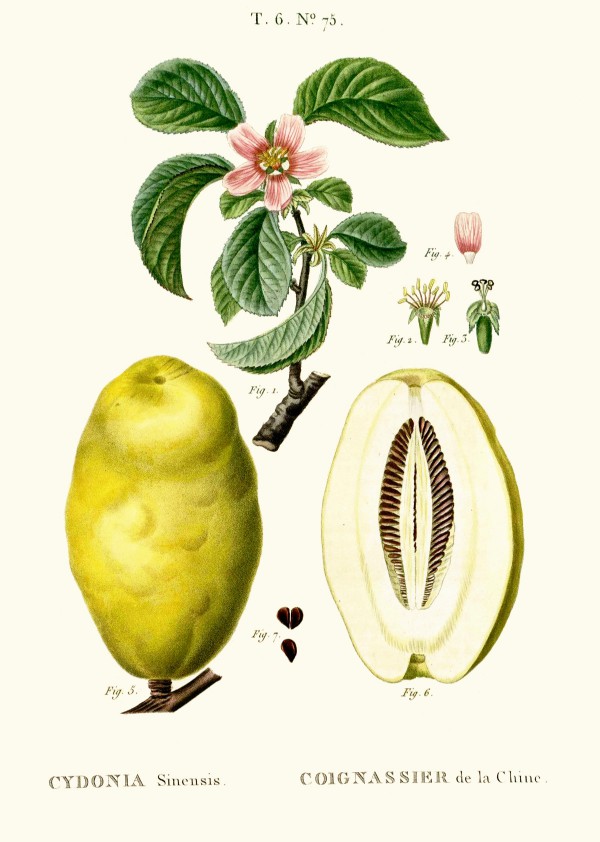Pseudocydonia sinensis (Thouin) C.K.Schneid. syn.Chaenomeles sinensis (Thouin) Koehne; Cydonia sinensis Thouin - Rosaceae
木瓜 mu gua (chinese), Chinese quince, Chinesische Quitte
Small deciduous tree or large shrub, 5-10m tall, native to China, also cultivated; bark flakey, sycamore-like, exfoliates into an attractive patchwork of gray, green and brown on the fluted mature trunks; leaves elliptic-ovate or elliptic-oblong, rarely obovate, 5-8cm long, shiny dark green; flowers solitary, 2.5-3cm in diam., cup-shaped, fragrant, petals pink; fruit (pome) dark yellow, narrowly ellipsoid, sweetly fragrant.
http://www.missouribotanicalgarden.org/PlantFinder/PlantFinderDetails.aspx?kempercode=d455
http://www.efloras.org/florataxon.aspx?flora_id=2&taxon_id=200010697
The flavor concentrate from the peel (0.0016%) was thought to be more important to Chinese quince aroma than from the flesh (0.0006%). Esters, alcohols, aldehydes and ketones are the most important volatile components. The large concentration of alkyl and alkenyl esters of omega-alkenoic acids (like ethyl 9-decenoate e.g.) and 5-hexenyl esters (ethyl 5-hexenoate e.g.) of aliphatic acids was remarkable. Aldehydes included C6 and C7 compounds and (E,E)-2,4-decadienal (0.05%) e.g.
(E,E)-α-farnesene (31.2%), isobutyl octanoate (11.1%), ethyl octanoate (4.8%), isobutyl 7-octenoate (4.4%), hexyl hexanoate (3.5%), and butyl 7-octenoate (3.0%) were the major components of Chinese quince oil obtained from the peel. Interesting minor components were β-dihydroionol (0.03%), α-ionone (0.02%), β-ionone (0.1%), the marmelo lactones (0.3%), trans-theaspirane (0.2%), and cis-theaspirane (0.05%).
[Mihara, Satoru, et al. „Volatile components of Chinese quince (Pseudocydonia sinensis Schneid).“ Journal of agricultural and food chemistry 35.4 (1987): 532-537], also in:
[„Flavors and Fragrances. A World Perspective,“ ed. by B. M. Lawrence, B. D. Mookherjee, and B. J. Wilis, Elsevier, Amsterdam, 1988, 537-550]
„Ethyl 2-methylpropanoate, ethyl (E)-2-butenoate, ethyl 2-methylbutanoate, methional, (Z)-3-hexenyl acetate, β-ionone, ethyl nonanoate, and γ-decalactone were detected as the potent aroma-active compounds (log3FD factors ≥ 5) in the peel of Chinese quince, while hexanal, (Z)-3-hexenal, and (Z)-3-hexenol, which have a green odor note, were potent aroma-active compounds with high log3FD factors (≥ 3) in the pulp of Chinese quince. In particular, ethyl propanoate, ethyl (E)-2-butenoate, and (Z)-3-hexenyl acetate - which had sweet and fruity aroma notes with relatively high FD factors - were detected in the samples extracted by HS-SPME.“
[Choi, Ji Young, et al. „Characterization of aroma-active compounds in Chinese quince (Pseudocydonia sinensis Schneid) by aroma dilution analyses.“ Food research international 105 (2018): 828-835]

Pseudocydonia sinensis (Thouin) C.K.Schneid. as Cydonia sinensis Thouin
H.L. Duhamel du Monceau, Traité des arbres et arbustes, Nouvelle édition [Nouveau Duhamel], vol.6 t.75 (1815) [P.Bessa]
http://botanicalillustrations.org/species.php?id_species=228339

Pseudocydonia sinensis, Setonaikai National Park, Japan (2025)
© geotropics CC BY-SA 4.0 inaturalist.org
